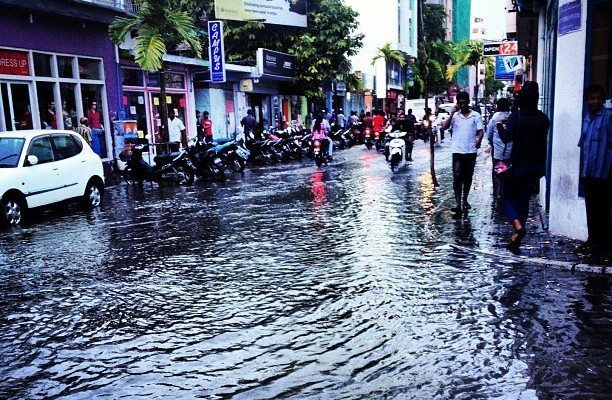 "It's a flood" courtesy of [Shazwan via Flickr]
"It's a flood" courtesy of [Shazwan via Flickr]
Energy & Environment
The Rising Tide of Flood Prevention Politics
As climate change worsens, melting ice from earth’s glacier sheet combined with the expansion of warming sea water has caused the world’s oceans to rise dramatically. There are a number of organizations dedicated to recording the rise in sea levels, including the Center for Operational Oceanographic Products and Services–a part of the NOAA that collects data on changing sea levels with numerous tide stations–and NASA, which use satellites to gather the same data from a different perspective. Currently, there are about 150 years of data gathered on changes in the Mean Sea Level (MSL) over time and the current scientific consensus is that sea levels have been rising at a rate of 3.42 mm annually over the last 20 years, which will lead to a total rise of between 1-2 meters by 2100.
Rising sea levels pose a very serious threat to many populous cities throughout the world, particularly those that have developed as coastal trade centers. As sea levels continue to rise, many of these coastal cities will become increasingly vulnerable to flooding, especially in the geographically low-lying areas of the earth. Flooding is a unique consequence of climate change in that it affects people both from the richest and the poorest parts of the world, and while everywhere has their own local approach to flood mitigation, there are generally two major ways to address the issue politically. The first and most popular approach is to develop coastal protection systems to prevent rising tides from impacting coastal zones. The second technique is to commit to renewable energy in order to directly address the problem of global warming and rising sea levels. The larger the country, the greater its personal commitment to fossil fuel divestment matters. Unfortunately, many of the largest countries which have the greatest carbon footprint generally make very low levels commitments to renewables, which makes the commitments of many of the smallest, most flood-vulnerable countries less significant.
Read on to learn more about how the different areas of earth are dealing with rising sea levels.

“Flood” courtesy of ddqhu via Flickr
The United States
The United States is an interesting case of flood politics because it’s one of the world’s wealthiest countries and thus most capable of handling flooding. However, there’s very little political consensus on the scientific validity of climate change in Congress and rising sea levels are rarely if ever mentioned in policy debates at the federal level. The government provides disaster relief funds for the areas that have been most severely affected by rising sea levels, but actual policy changes generally must happen at the individual, state, or even city level. Several areas throughout the United States face a high risk of flood inundation, including New York City; Newark, New Jersey; Boston; Miami; New Orleans; and the entire state of Hawaii.
Hawaii
Hawaii is relatively low-lying compared to the rest of the U.S. mainland and a sea level rise of 1-2 meters would absolutely devastate the state. Furthermore, each island is so small that there’s very little inland area, meaning that few people would be safe from flooding. It’s no coincidence that Hawaii leads the United States in addressing climate change and is the very first state to commit to getting 100 percent of its energy from renewable sources. This also makes sense from a business perspective because it’s very expensive to ship oil and gas to Hawaii and the state is geographically blessed with ample renewable resources. However, the decision to commit to renewables was made largely out of necessity, as Hawaii’s community, as well as its primary source of revenue, the tourism industry, would suffer immensely from the effects of flooding. Of course, Hawaii’s commitment is a drop in the bucket compared to all U.S. emissions. However, its decision allows the state to lead policy by example and proves that 100 percent renewables are an attainable goal. For a real impact to take place, the other states must follow suit, along with many of the world’s countries.
Cities: New Orleans, New York, and Miami
None of the other states are as universally vulnerable to flooding as the state of Hawaii, but several have been forced to take measures to protect their largest population centers. Cities like New Orleans and New York City are at particularly high risk not only because they are located on high-risk coasts but also because they’re located in areas that are extremely vulnerable to severe weather events, as seen with hurricanes Sandy and Katrina. New York has made its own commitment to 50 percent renewables by 2030 and has also tried to take more immediate action to prevent Sandy-level flooding from happening again. The current plan is to allocate $100 million of Sandy’s relief funds to the construction of a wall to protect the city as well as apply for an additional $500 million dollars of Federal Housing and Urban Development Funds. The project will be very expensive and require a huge amount of resources, but without flood protection, New York’s electric grid and underground subway system could be completely dismantled, crippling an economic center of the nation and costing billions of dollars in restoration funds.

“Coastal Flooding in Washington DC” courtesy of Bruno Sanchez-Andrade Nuño via Flickr
New Orleans suffered an even greater extent of damage from Hurricane Katrina than New York did from Hurricane Sandy and has also bounced back at a considerably slower rate. Unlike New York, New Orleans is a relatively poor city and was largely at the mercy of how the federal government decided to handle the situation. Congress allocated a massive $14.5 billion relief package to construct an upgraded levy system designed by the U.S. Army Corps of Engineers. The new and improved system will be much better equipped to protect against flooding, but the upgrade has met some serious criticism. Even the Army Corps of Engineers has warned that there’s a limit to what it can do based on New Orleans’ geography. The area is uniquely low-lying and most of the natural marshes that have historically acted as flood barriers have disappeared over the years, stripping the city of its natural protection.
The political context of different vulnerable areas also heavily influences the way decisions are made. Miami, for instance, is also only 4 to 5 feet above sea level and the entire beach may disappear within the century if sea levels continue to rise. While the state has sunk hundreds of millions into flood prevention, Florida has almost no renewable power at all and has made few steps towards achieving its Renewable Portfolio Standard of 20 percent by 2020. The difference between New Orleans, Miami, and New York’s approaches to their vulnerability represents how wealth, political nature, and geographical position strongly influence what is and what can be done to address the risks of flooding. While commitments to renewable energy address the larger problem of global warming and sea level rise, they do little to directly impact an area’s vulnerability to flooding. This generally means that if renewables aren’t cost effective and receive political opposition, then they will rarely be considered as a valid policy option.
The European Union
The areas of Europe that face the highest risk of flooding are the United Kingdom, the Netherlands, Scandinavia, and Northern Germany because of their flat geography and proximity to the rapidly melting Greenland Ice Sheet. Flood prevention has become a serious issue in the European Union, not only because these areas are at high risk from sea level rise but also because Central and Eastern Europe have experienced rising levels of river flooding from severe weather events. In response to these changes, the European Union made one of the European Regional Development Fund’s duties to establish structural funds for flood mitigation and adaptation. Furthermore, every member of the European Union has their own Renewable Energy Target, which varies widely depending on the location.
However, in a parallel that runs somewhat similar to how only a select set of vulnerable U.S. states address flood risk aggressively, only a handful of European states have serious flood policies. While the overarching body of the E.U. provides structural adaptation funds in the same way the U.S. provides federal disaster relief funds, flood control is only a highly salient issue in the northernmost parts of the continent. The most dramatic example of this is the Netherlands, which is an incredibly low-lying nation that also has an extensive canal system that runs a high risk of flooding. The sea surrounding the Netherlands was originally projected to rise about 1.05 meters within the century, but newer models project a 26 percent chance that the sea will actually rise to 1.8 meters, making it the most vulnerable European nation. England is not far behind, with a renewed projection that there’s a 27 percent chance of sea level in the surrounding areas by 1.75 meters. Both countries have extensive coastal protection policies in the form of barriers, dikes and sluice gates, but many scientists fear that this will not be enough to protect them from flash floods in the future.
The World’s Most Vulnerable Areas
As with many serious environmental issues, the developing world faces some of the greatest risks from these problems but has the least resources dedicated to addressing them. While the Middle East and North Africa (MENA) is generally (and accurately) characterized as being an incredibly dry and hot region, the coastal areas between the two continents face serious risks from flooding. If sea levels rise between 0.1 and 0.3 meters by 2050 as predicted, the coastal regions of Libya, Qatar, the United Arab Emirates, Egypt, and Kuwait could be exposed to severe flooding. A temperature rise of 1 to 3 degrees would exacerbate sea level rise to the point where it would critically endanger urban coastal areas, and could expose six to 25 million people in Northern Africa to flooding.
Many of these areas, including Algeria, Morocco, Djibouti, Lebanon, and Yemen have designed Disaster Risk Management Plans to increase resilience in their cities in preparation for oncoming natural disasters. However, many of the MENA countries are actively involved in the Organization of Petroleum Exporting Countries (OPEC) whose economies are heavily dependent on the fossil fuel industry. The leaders of OPEC generally admit that climate change is real but are quick to dismiss efforts to regulate fossil fuels. They view the push against oil in international negotiations as an unfair handicap against their industries and generally fight against any attempt to regulate or shrink the fossil fuel market. Despite the fact that MENA will suffer some of the worst effects of climate change (taking into account desertification as well as flooding), it seems unlikely that the area will diverge from fossil fuels at any point in the foreseeable future.
Many parts of South America, including Venezuela, Argentina, Uruguay, Paraguay, Brazil along with almost every country in Southeast Asia, are also at some of the highest risks of flooding in the world. Unlike the MENA region, few of these countries fight with the same vigor to support the fossil fuel industry, with the exception of Venezuela, the only non-MENA member of OPEC. However, many will still fight for their personal rights to use fossil fuel projects in the name of internal development since the majority of the burden of climate change was caused by the developed world. The issue of flooding is further exacerbated by the fact that several of the countries in these regions have resource extraction economies that rely on deforestation, which steadily shrinks their natural riparian protection from rising sea levels.
Perhaps the worst example of a disenfranchised flood-vulnerable country is the Maldives, both one of the poorest and the lowest lying island nations in the world. As sea levels continue to rise, the Maldives will be one of the first countries to become completely inundated, despite the fact that as a developing country it has contributed a very small percentage of the emissions that have contributed to climate change. The Maldives’ first ever democratically elected leader, Mohamed Nasheed, committed his country to achieving 100 percent renewable energy and made the Maldives the very first country to sign onto the Kyoto Protocol. He encouraged a massive reforestation program along the beaches to prevent soil erosion and act as a riparian barrier from flooding. He also initiated litter cleanup programs and special protection for the coastal reefs that protect the nation’s boundaries.
The actions of a small country like the Maldives will help give it better protection but will do little to fight climate change without the commitment of larger nations in North America and the European Union to reduce emissions. While the Maldives’ commitment to clean energy would have had a small impact on global emissions, they stood as an important symbol of forward progress, especially to other vulnerable island states. However, in January, Mohammed Nasheed was overthrown and imprisoned after allegedly ordering the arrest of a judge. The brother of the previous dictator rose to power and has undone all of Nasheed’s efforts, promising to tear up every tree he had planted. The Maldives’ high level of vulnerability combined with its new lack of a flood adaptation policies places it at extreme risk from sea level rise and within 100 years the island is projected to be uninhabitable.
Conclusion
Rising sea levels are a problem that will affect countless areas, both in the developing and the developed world. The exact decisions that governments will make heavily depend upon their political affiliation, what is geographically possible, and how much funding they can reasonably allocate to combating flooding. Much of this means that the poorest areas of the world are disproportionately affected because they neither have the resources nor the political organization needed to address these problems. Furthermore, they may have economies based on resource extraction industries, which further exacerbate their vulnerability.
Globally, considerable resources have been dedicated to flood prevention, but little commitment has been made to abating fossil fuels in the name of halting sea level rise. This is largely because it’s extremely difficult to establish federal and international policy on climate change, so often policy changes happen on a more local level. Because these decisions are made by smaller, more vulnerable entities instead of larger international organizations, these areas will often settle for mitigation policy instead of prevention based, emissions reductions policy. However, as long as climate change continues, then the root of the problem will continue to exist and sea levels will continue to rise. At the current rate, several areas around the world, including the Maldives, will inevitably become uninhabitable and unless large-scale changes in global emissions are made, more and more countries will suffer the same fate.
Resources
The Atlantic: Is Miami Beach Doomed?
BBC: Former President Mohammed Nasheed Allowed Foreign Trip
BBC: Maldives: Paradise Soon to be Lost
Climate Central: New Analysis Shows Global Exposure to Sea Level Rise
Energy Information Administration: Florida Profile Overview
European Commission: Flood Risk in Europe: Analysis of Exposure in 13 Countries
Floodlist: Thousands Displaced by Flooding Rivers in Uruguay, Paraguay, Brazil, Argentina
Florida State University: Florida’s Renewable Energy Future Depends on Incentives for Renewables
Green Biz: New York’s Plan to Reach 50 percent Renewable Energy
International Institute for Applied Systems Analysis: European Flood Risk Could Double by 2050
Karen and Clark Company: Most Vulnerable Cities to Storm Surge Flooding
The Lens: New Orleans Flood Protection System: Stronger than Ever, Weaker than it was Supposed to be
Live Science: The 20 Cities Most Vulnerable to Flooding
Nation of Change: Hawaii Enacts Nation’s First 100 Percent Renewable Energy Standard
NASA: Global Climate Change: Sea Level Rise
Nature World News: Climate Change and Sea Level: England, Europe at Risk of Major Sea Level Rise
NCBI: Floods in Southeast Asia: A Health Priority
The New Yorker: The Siege of Miami
Niels Bohr Institute: Risk of Major Sea Level Rise in Northern Europe
NOLA: Upgraded Metro New Orleans Levees will Greatly Reduce Flooding, Even in 500-Year Storms
Renewable Energy Action Coalition of Hawaii: Planning Hawaii’s 100 percent Renewable Energy Future
Tech Insider: Hawaii is Harnessing 100 percent Renewable Energy 0 with Active Volcanoes
Time: Why New York City will Be Flooded More Often
USA Today: One Year After Sandy, 9 Devastating Facts
World Bank: Adaptation to Climate Change in the Middle East and North Africa Region
World Bank: Water in the Arab World: From Droughts to floods: Building Resilience Against Extremes
Yale Environment 360: A Plague of Deforestation Sweeps Across Southeast Asia
ZME Science: New Study Highlights Vulnerability of Low Lying Hawaiian Islands








Comments